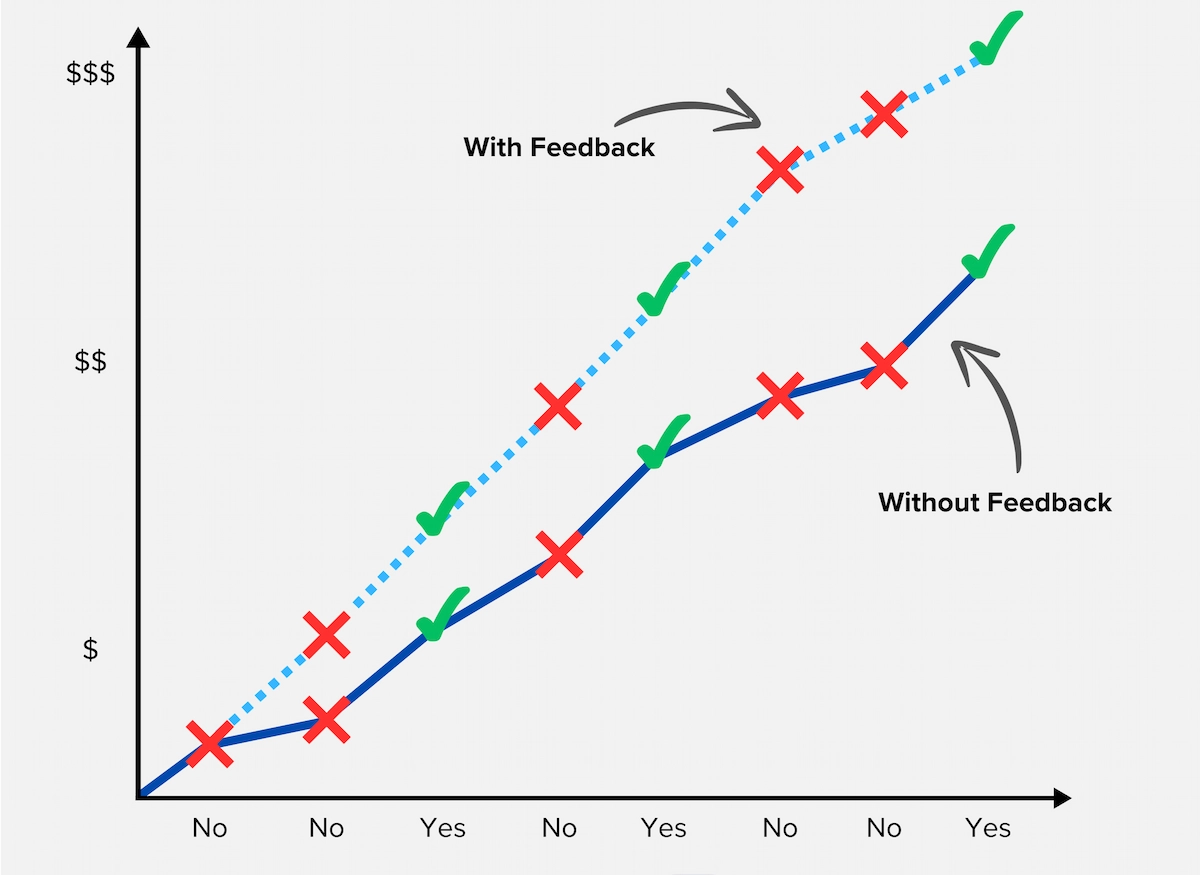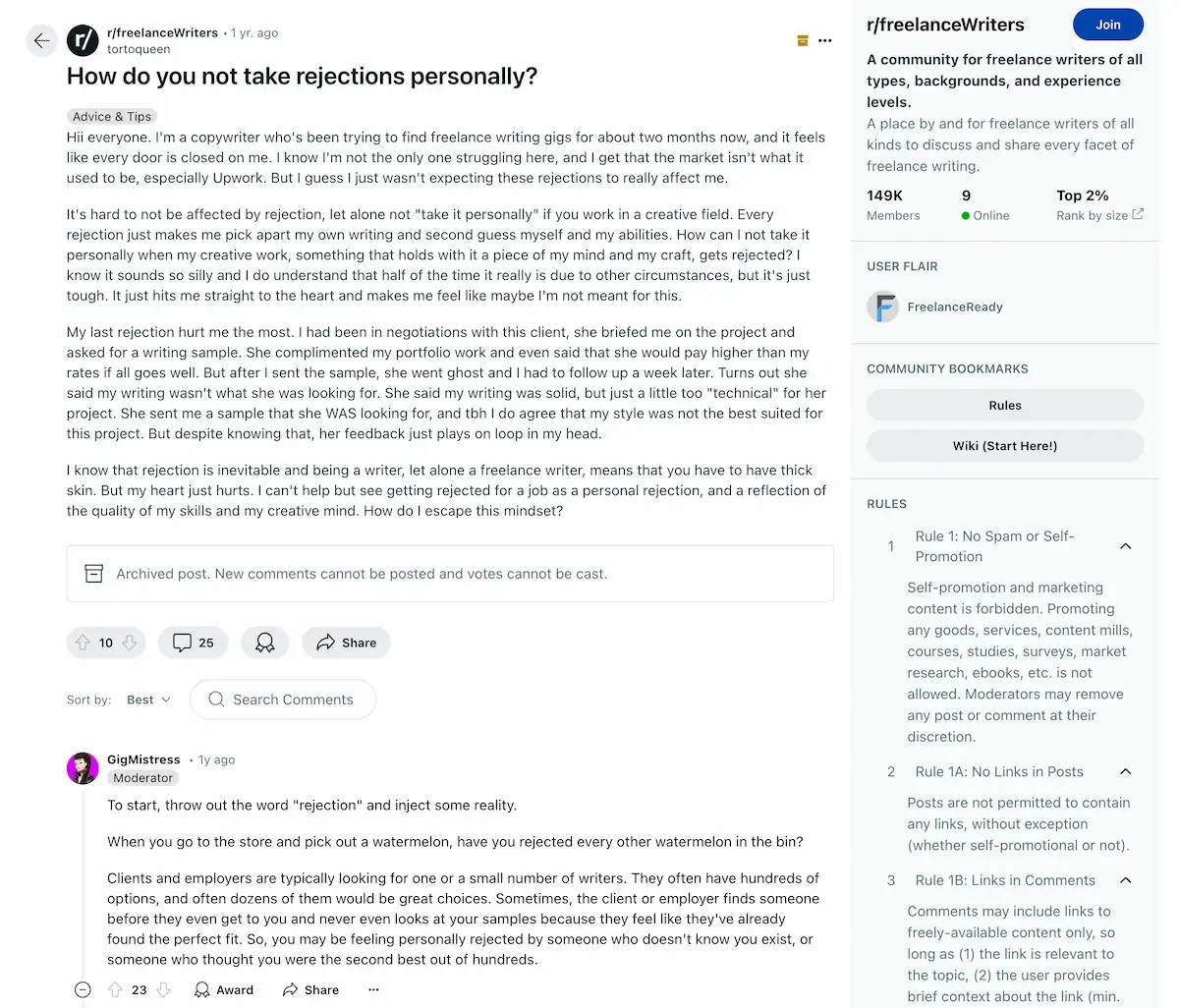Dealing with rejection is an inevitable part of being a freelancer. It can be tough, disheartening, and even make you doubt your abilities. But it’s important to remember that rejection is not a reflection of your worth or talent.
Instead of letting it bring you down, use it as an opportunity for growth and improvement.
Below, I go into some ways to handle rejection professionally and bounce back stronger than ever, based on my own experience of being told “No” a lot!
Note: Stick around to the end for some of the main reasons you’re likely getting rejected as a freelancer.
1. Embrace A Growth Mindset
Instead of simply viewing rejection as a personal failure, you should see it as a chance to learn and grow. Understand that setbacks are a natural part of the freelancing journey.
Take a step back, assess the situation objectively, and ask yourself, “What can I learn from this experience?”
By shifting your perspective, you can turn rejection into an opportunity for self-improvement. And with that improvement can come more lucrative opportunities in the future.

2. Seek Constructive Feedback
Receiving feedback, even if it’s negative, can be incredibly valuable. Reach out to the client or employer who rejected your work and kindly ask for constructive feedback. And be open-minded and receptive to their suggestions.
Understanding their perspective can help you identify areas where you can enhance your skills or make necessary adjustments to your work. Helping you grow much faster as a freelancer.

Remember:
Feedback is not a personal attack, and you should seek it out when you can.
It can point you in the direction of changes you need to make to become a better freelancer.
3. Reframe Rejection As A Learning Experience
Rather than dwelling on the rejection itself, focus on what you can gain from the experience. Treat each rejection as a valuable lesson that can propel your professional growth. Reflect on the situation and analyze the factors that may have contributed to the rejection.
Did you overlook any specific requirements?
Was there a misalignment in communication?
Use these insights to improve your approach in future projects and prevent similar rejections.
4. Keep It Professional
When faced with rejection, it’s essential that you maintain professionalism and grace. Avoid responding in anger or frustration, as it can harm your reputation and future prospects. And it’s also just not the right way to go about things in general.
Instead, thank the client for their time and consideration. Express your willingness to collaborate in the future and leave a positive impression. (And bear in mind my second point—ask for feedback!)
Remember, the freelance community is smaller than you think. And maintaining a professional demeanor can open doors to new opportunities down the line.
5. Network & Seek Support
Rejection can also make you feel isolated and alone. But it doesn’t have to.
Reach out to fellow freelancers or join professional communities where you can connect with like-minded individuals. Surrounding yourself with a supportive network of peers can provide valuable insights, encouragement, and guidance.
Even a simple forum (like the freelance writing subreddit) can provide some much needed support:

Share your experiences, seek advice, and learn from others who have overcome similar challenges.
Now you know how to deal with rejection, it’s worth exploring why your freelance clients keep saying no.
Why Do You Keep Getting Rejected As A Freelancer?
Here are some of the most common reasons you’re likely being rejected as a freelancer:
You Don’t Have The Relevant Skills Or Experience
One possible reason for freelancer rejection could be a lack of relevant skills or experience. Clients or employers often look for freelancers who have a proven track record in their field or possess specific expertise.
If you’re consistently facing rejection, take a critical look at your skill set and evaluate if there are any gaps. If there are, invest some time into enhancing your skills through online courses, workshops, or practical projects.
Note: If you need some additional freelancing help, check out our guide to the top freelancing books.
You Misunderstood The Client’s Expectations
Sometimes, rejection can occur because there’s a mismatch between your skill set and the client’s expectations. This can happen if you haven’t thoroughly understood the project requirements or if the client’s needs don’t align with your particular strengths.
To avoid this, ensure you communicate effectively with clients before accepting a project. Ask detailed questions and clarify expectations early on. Taking the time to assess client requirements upfront can save you from unnecessary rejections later on.
(It might even be you that realizes it’s not a good fit, as sometimes you’ll be the one saying no.)
You Didn’t Communicate Well Enough
Effective communication and professionalism are crucial in the freelancing world. Poor communication can lead to misunderstandings, missed deadlines, and, ultimately, rejection.
Maintain clear and timely communication with clients throughout the project. Respond promptly to emails, be proactive in seeking clarification when you’re unsure about anything, and keep clients up to date on your progress.
They will often love that, because not all freelancers do it. I’ve personally had feedback highlighting this specific point:

Professionalism also extends to meeting deadlines and submitting high-quality work. By improving your communication and professionalism, you can increase your chances of getting more freelance clients.
Your Pricing Doesn’t Fit
In a highly competitive freelance market, pricing can significantly impact your success rate. If you consistently face rejection, it may be worth reassessing your rates.
Are they too high compared to others in your field?
Are they too low, potentially signaling a lack of quality?
Research market rates and align your pricing strategy accordingly. Remember, clients often look for a balance between quality and affordability. Finding the right pricing sweet spot can help you stand out and increase your chances of getting a Yes instead of a No.
Further reading: How To Set Freelancing Rates
You Didn’t Sell Yourself Well Enough
As a freelancer, self-promotion plays a crucial role in attracting clients and securing projects. If you’re continuously facing rejection, ask yourself the following questions:
- Are you effectively showcasing your skills and experience?
- Do you have a strong online presence, such as a professional website or portfolio?
Invest some time into building your personal brand. Build a solid portfolio and use social media to showcase your work. Strengthening your marketing efforts can improve your visibility and help you attract more potential clients.
You Didn’t Learn From Previous Rejections
Rejection can be a valuable learning opportunity if you approach it with the right mindset. If you’re repeatedly facing rejection, reflect on previous experiences and identify patterns or areas for improvement.
Ask for feedback from clients who rejected your work and use their insights constructively. Use this feedback to refine your skills and address any recurring issues.
If you don’t learn from past rejection, you’re doomed to continue getting rejected for the same reasons!
Use Rejection To Grow As A Freelancer
We all get rejected at some point as a freelancer—it’s inevitable. However, rejection can be a great opportunity to learn why you’re not the right choice for clients and change the way you offer your services.
Freelancing is a long journey, and the bumps along the way are well worth it!
Freelance Ready is reader-supported. That means some links on this website are affiliate links. If you sign up or make a purchase through these links, we may earn a commission.

